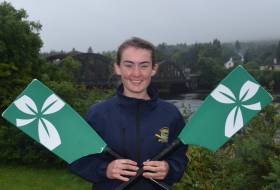Displaying items by tag: Georgia O'Brien
#Rowing: Commercial won the men's eight in a close and exciting final race of Metropolitan Regatta at Blessington today. UCD and the Irish champions were neck and neck in the final stages, but UCD had the advantage until the sprint to the line, which Commercial won.
The concluding session of finals featured an even closer race.
In the women's four, two junior crews hit the line with just .297 of a second between them. Bann, on the far side of the course from the viewing area, saw their lead snatched away by Castleconnell.
Kenmare's Georgia O'Brien (20) won her singles sculls final with much more to spare, though the second placing gave Aoife Moloney of Commercial victory in the junior 18 rankings.
There were also big margins of victory for Lagan in the men's quadruple and Anna Liffey in the women's pair.
Shane Haugh and James O'Donovan won the men's double. Last weekend O'Donovan was part of the Ireland coxed four which took silver at the European Junior Championships.
Golden Girl O'Brien Extends Ireland Run at Coupe Rowing
#Rowing: Georgia O’Brien of Kenmare took Ireland’s second gold of the day at the Coupe de la Jeunesse regatta in Hazewinkel in Belgium this afternoon. The single sculler had won her heat in the morning session and she did it again in the A Final in a slightly faster time, just pipping France’s Virginie Liot. Britain’s Jane Hardie took the bronze.
Earlier, the Ireland junior men's quadruple had taken gold.
Coupe de la Jeunesse, Hazewinkel, Day One (Irish interest)
Junior Men
Four – Heat One (First Three to A Final): 3 Ireland (A Johnston, R Corrigan, B Connolly, N Timoney) 6:23.78. A Final: 5 Ireland 6:27.89.
Quadruple – Heat One: 1 Ireland (B O’Flynn, M Dundon, J Keating, J Quinlan) 6:12.81. A Final: 1 Ireland 6:12.16, 2 Italy 6:14.58, 3 Britain 6:15.07.
Junior Women
Single Sculls – Heat Two (First Three to A Final): 1 Ireland (G O’Brien) 8:10.17. A Final: 1 Ireland 8:09.83, 2 France 8:10.16, 3 Britain 8:14.57.
#Rowing: Georgia O’Brien has been chosen to represent Ireland at the Coupe de la Jeunesse. The Kenmare girl was added to the team, which will compete in Belgium on July 29th and 30th, after Cork Regatta. However, Rory Quinn and Oisin Clune, who had been in the mix for the Coupe de la Jeunesse team, were not chosen. They have been named in the team for the Home International Regatta in Scotland on July 22nd.
| Junior Team selections 2017 |
|---|
| The following junior teams have been selected to race at international regattas this coming summer. |
| Junior World Championships (Trakai, Lithuania, August 2-6) |
| JW2x |
| Margaret Cremen (Lee Rowing Club) |
| Aoife Casey (Skibbereen RC) Coach: Dan Buckley (Lee RC) |
| (Eleanor Casey, Skibbereen RC will travel with the crew as chaperone). |
| Coupe de la Jeunesse (Hazewinkel, Belgium, July 29-30) |
| JM4x- |
| Barry O'Flynn (Cork BC) |
| Matt Dundon (Clonmel RC) |
| Jack Keating (Carlow RC) |
| James Quinlan (Castleconnell BC) Coach: Ray Morrison (Fermoy RC) JW1x Georgia O' Brien (Kenmare) Coach: Ray Morrison (Fermoy RC) |
| JW2- |
| Ellie O' Reilly (Fermoy) |
| Gill McGirr (Fermoy) Coach: John Walsh (St Joseph's RC) |
| JM4- |
| Nathan Timoney (Enniskillen) |
| Barry Connolly (Cork BC) |
| Ross Corrigan (Enniskillen) |
| Aaron Johnston (Enniskillen) Coach: John Walsh (St Joseph's RC) |
| Home International (Strathclyde, Scotland, July 22) |
| Junior Women - Sweep Team |
| JW 4+ |
| Siobhan Maxwell (Commercial) |
| Aishling Keogh (Commercial) |
| Mia Kovacs (Shandon) |
| Chelsey Minehane (Shandon) |
| Cox: Vicky Hanlon (Cork BC) |
| JW4- |
| Mia Jane Elliot (Enniskillen) |
| Zoe McCutcheon (Enniskillen) |
| Caitlyn Fee (Enniskillen) |
| Miriam Kelly (Enniskillen) |
| JW2- |
| Megan Tully (Shannon) |
| Megan Carmody (Shannon) Coach: Fran Keane (Presentation College RC) |
| *The JW Eight will be a combination of the 4+ and the 4- |
| Junior Men - Sweep Team |
| Olly O' Toole (Commercial) |
| Edward Meehan (Commercial) |
| Michael Lynch (Commercial) |
| Ewan Jarvis (Commercial) |
| Tom McKeon (SMRC) |
| Dylan O' Byrne (SMRC) |
| Odhran Donaghy (Enniskillen) |
| Jack Dorney (Shandon) |
| Calum MacRae (Methodist) |
| Alexander Wilson (Methodist) |
| Cox: Rory Farragher (Enniskillen) Coach: Stewart Davis (Lee RC) |
| Junior Women - Sculling Team |
| Cliodhna Nolan (Carlow RC) |
| Ciara Browne (Workmans) |
| Anna O'Sullivan (Fermoy RC) |
| Ciara Moynihan (Workmans) |
| Aoibhinn Keating (Skibbereen) |
| Ella Buckley (Lee Valley) |
| Ruth Carson (Bann) Coach: Amy Phelan (Colaiste Iognaid) |
| Junior Men - Sculling Team |
| Aaron Christie (Bann) |
| Tadhg McKnight (Three Castles) |
| Andy O' Toole (Carlow) |
| Ross O' Brien (Carlow) |
| Alex Byrne (Shandon BC) |
| Rory Quinn (Three Castles) |
| Oisin Clune (Three Castles) Coach: TBC |































































